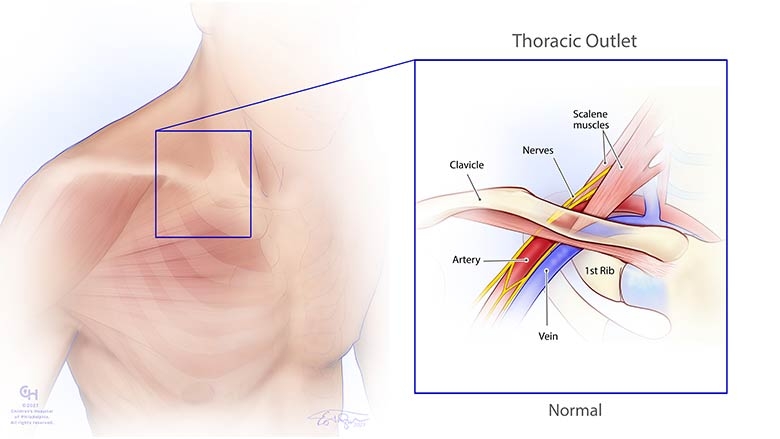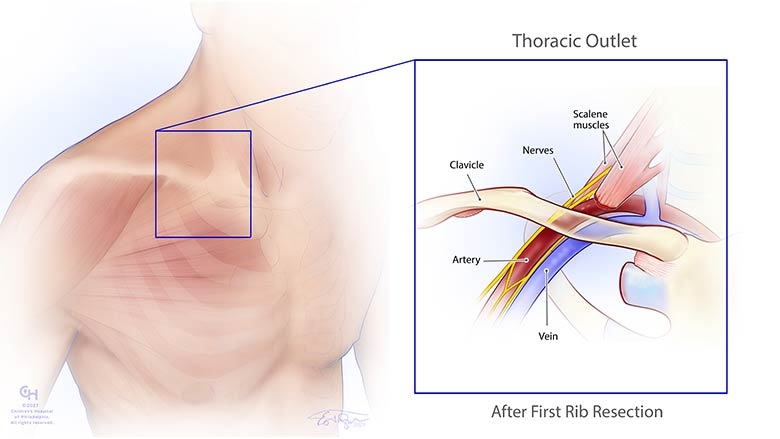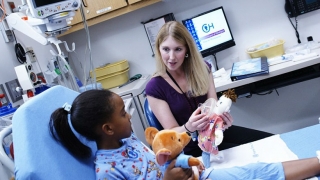Thoracic Outlet Syndrome in Children and Teens
What is thoracic outlet syndrome?
The thoracic outlet is the space between the first rib and the clavicle. Major nerves and blood vessels in the arm travel through this space. Thoracic outlet syndrome results from compression of those neurovascular structures within the thoracic outlet. Thoracic outlet syndrome is a form of vascular disease.
 Thoracic outlet syndrome happens when bones or muscles in the upper chest press on nerves or blood vessels. The compression leads to pain, tingling or numbness in the neck or arm.
Thoracic outlet syndrome happens when bones or muscles in the upper chest press on nerves or blood vessels. The compression leads to pain, tingling or numbness in the neck or arm.
Causes of thoracic outlet syndrome
The cause of thoracic outlet syndrome is often genetic, such as being born with an extra rib or muscle in the neck. It is also a common condition in athletes who use their arms and shoulders in repetitive motions. This includes swimmers, rowers, baseball players and volleyball players.
Symptoms of thoracic outlet syndrome
There are three different types of thoracic outlet syndrome.
- Venous/Paget-Schroetter syndrome/Effort thrombosis – In this syndrome, repetitive overhand motions put pressure on subclavian/axillary vein. This can cause swelling and pain. In extreme cases, it can cause a blood clot.
- Neurogenic thoracic outlet syndrome – In this condition, there is compression of the brachial plexus. This is the main bundle of nerves for the arm. This compression can lead to constant pain and loss of function in the shoulders, arms and hands. In this syndrome, repetitive overhand motions put pressure on subclavian/axillary vein. This is the artery that supplies blood to the arm. This can cause pain, tingling and decreased function of the upper extremity.
- Arterial thoracic outlet syndrome – In this condition, there is compression of the subclavian/axillary artery. This is the artery that supplies blood to the arm. This can lead to a decrease in blood flow to the upper extremities. In some cases, it can cause an aneurysm to develop or can lead to risk of limb loss.
Testing and diagnosis of thoracic outlet syndrome
At Children’s Hospital of Philadelphia (CHOP), the first step in caring for a child with thoracic outlet syndrome is a thorough evaluation by a multidisciplinary team of experts.
We use the most advanced imaging technology available. Our technologists have special training. They will make sure your child receives an accurate, detailed diagnosis. This is an important first step in offering a personalized treatment plan for your child. We give you the information you need to help you make informed decisions about your child’s care.
Tests and imaging can help give us more answers about your child’s condition. These tests include:
- Nerve conduction studies
- Vascular ultrasound studies
- Chest X-ray
- Computed tomography (CT) scan
- Magnetic resonance imaging (MRI)
- Magnetic resonance imaging with angiography (MRA)
- Arteriogram/venogram
Treatment for thoracic outlet syndrome
Our team includes experts from various specialty areas. They provide the full range of care for children with thoracic outlet syndrome. For severe or constant symptoms, vascular surgery can be a potential treatment option.
At CHOP, your child has access to world-class care. Our team includes pediatric experts from every specialty. This includes general surgery, nephrology, interventional radiology, cardiology, cardiac surgery, hematology and genetics, among others.
We work together to provide the best care for each patient. Close monitoring and long-term follow-up are key.
 Removing the 1st rib will relieve the compression and ultimately improve symptoms of thoracic outlet syndrome.
Removing the 1st rib will relieve the compression and ultimately improve symptoms of thoracic outlet syndrome.
Contact Us
Whether your child was just diagnosed with thoracic outlet syndrome, or you’ve been on this journey for a while and are looking for a second opinion, we are here to help.

